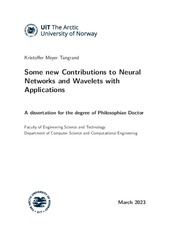| dc.contributor.advisor | Bremdal, Bernt | |
| dc.contributor.author | Tangrand, Kristoffer Meyer | |
| dc.date.accessioned | 2023-03-07T12:33:28Z | |
| dc.date.available | 2023-03-07T12:33:28Z | |
| dc.date.issued | 2023-03-21 | |
| dc.description.abstract | <p>In this Ph.D. thesis, we focus on some problems of general interest both in engineering sciences and applied mathematics. The close connection between some problems concerning neural networks, wavelets, structural health monitoring, and modern Fourier analysis is highlighted and applied in various ways. The main body of the Ph.D. thesis consists of six papers, A–F, which are put into
a more general frame in the introduction.
<p>In Paper A we present a case for how systematic use of energy flexibility can be an important instrument for managing peak loads and voltage problems in weak power grids. The FLEXNETT Simulator addresses production and energy dynamics down to every 10 minutes. A recurrent neural network was used to generate realistic values for the simulator.
<p>In Paper B we made a case for using a combination of time series from nonintrusive ambient sensors and recurrent neural networks to predict room usage at a university campus. Training data was created by collecting measurements from ambient sensors measuring room CO<sub>2</sub>, humidity, temperature, light, motion, and sound.
<p>The findings in papers A and B led to inquiries concerning the learning ability of machine learning models.
<p>In Paper C we propose a new approach to machine learning of geometric manifolds in <i>R<sup>n</sup></i> using single-layer or deep neural networks, Wavelet-Based Neural Networks (WBNN). Deep WBNNs provide a highly efficient computing architecture for the acceleration of the rate of convergence of the approximation process by using iterative algorithms. The investigations in paper C inspired further research on actual engineering problems where, e.g., wavelets are of crucial importance.
<p>In Paper D we investigate the impact of extreme arctic conditions on civil engineering infrastructures. Research and development of new methods are needed for damage detection in these structures. Advances in artificial intelligence could help solve the problem of structural damage detection, especially in arctic regions.
<p>In paper E, a new example of the applications of operational modal analysis (OMA) techniques to a concrete railway arch bridge located over the Kalix river in Långforsen is presented. Results from theOMAtechniques are used for finite element model (FEM) updating. Furthermore, artificial intelligence algorithms that can be useful for addressing the problem of missing data sets in structural health monitoring technologies are presented.
<p>The questions discussed in papers D and E are not only related to neural networks and wavelets but also to modern Fourier analysis.
<p>In paper F we prove some new inequalities and sharpness results concerning the Walsh-Fourier series. Moreover, a close connection between these series and wavelet theory is pointed out. | en_US |
| dc.description.doctoraltype | ph.d. | en_US |
| dc.description.popularabstract | New Ph.D. thesis explores connections between neural networks, wavelets, and modern Fourier analysis
A new Ph.D. thesis from UiT explores the connections between neural networks, wavelets, and modern Fourier analysis and how they can be applied to various problems in engineering sciences and applied mathematics. The thesis consists of six papers, which address topics ranging from the systematic use of energy flexibility in weak power grids to predicting room usage at a university campus to new inequalities and sharpness results concerning the Walsh-Fourier series.
The investigations in the papers have led to new insights and potential solutions to problems in areas such as structural health monitoring and machine learning. The use of recurrent neural networks and wavelet-based neural networks has been shown to be effective in generating realistic values and accelerating the rate of convergence of approximation processes.
The findings of the thesis demonstrate the potential for further research and development in these areas and the usefulness of combining these fields for solving complex problems in engineering and applied mathematics. | en_US |
| dc.identifier.isbn | 978-82-7823-245-3 | |
| dc.identifier.isbn | 978-82-7823-246-0 | |
| dc.identifier.uri | https://hdl.handle.net/10037/28699 | |
| dc.language.iso | eng | en_US |
| dc.publisher | UiT Norges arktiske universitet | en_US |
| dc.publisher | UiT The Arctic University of Norway | en_US |
| dc.relation.haspart | <p>Paper A: Tangrand, K. & Bremdal, B. (2019). The FlexNett Simulator. <i>IOP Conference Series: Earth and Environmental Science (EES), 352</i>, 012005. Also available in Munin at <a href=https://hdl.handle.net/10037/16729>https://hdl.handle.net/10037/16729</a>.
<p>Paper B: Tangrand, K. & Bremdal, B. (2020). Using Deep Learning Methods to Monitor Non-Observable States in a Building. <i>Proceedings of the Northern Lights Deep Learning Workshop, 1</i>, 1-6. Also available in Munin at <a href=https://hdl.handle.net/10037/21194>https://hdl.handle.net/10037/21194</a>.
<p>Paper C: Dechevsky, L. & Tangrand, K. (2022). Wavelet Neural Networks versus Wavelet-based Neural Networks. Technical report, UiT The Arctic University of Norway, 48 pages. Also available on Arxiv.org at <a href=https://doi.org/10.48550/arXiv.2211.00396>https://doi.org/10.48550/arXiv.2211.00396</a>.
<p>Paper D: Tangrand, K. & Singh, H. Analysis of Civil Engineering Infrastructure in Norway With Solutions Based on Structural Health Monitoring and Artificial Intelligence. (Submitted manuscript).
<p>Paper E: Tangrand, K., Singh, H. & Grip, N. (2022). A Comprehensive Study of Wavelets and Artificial Intelligence Algorithms for SHM andits Application on a Concrete Railway Arch Bridge. Technical report, UiT The Arctic University of Norway, 2022, 17 pp.
<p>Paper F: Baramidze, D., Persson, L.E., Tangrand, K. & Tephnadze, G. <i>H<sub>p</sub> – L<sub>p</sub></i> Type Inequalities for Subsequences of Nörlund Means of Walsh-Fourier Series. (Accepted manuscript). | en_US |
| dc.rights.accessRights | openAccess | en_US |
| dc.rights.holder | Copyright 2023 The Author(s) | |
| dc.rights.uri | https://creativecommons.org/licenses/by-nc-sa/4.0 | en_US |
| dc.rights | Attribution-NonCommercial-ShareAlike 4.0 International (CC BY-NC-SA 4.0) | en_US |
| dc.title | Some new Contributions to Neural Networks and Wavelets with Applications | en_US |
| dc.type | Doctoral thesis | en_US |
| dc.type | Doktorgradsavhandling | en_US |


 English
English norsk
norsk
